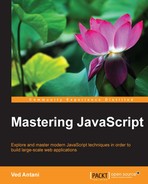So far, we have taken a detailed tour of the JavaScript programming language. I am sure that you must have gained significant insight into the core of the language. What we saw so far was as per the ECMAScript 5 (ES5) standards. ECMAScript 6 (ES6) or ECMAScript 2015 (ES2015) is the latest version of the ECMAScript standard. This standard is evolving and the last round of modifications was done in June, 2015. ES2015 is significant in its scope and the recommendations of ES2015 are being implemented in most JavaScript engines. This is great news. ES6 introduces a huge number of features that add syntactic forms and helpers that enrich the language significantly. The pace at which ECMAScript standards keep evolving makes it a bit difficult for browsers and JavaScript engines to support new features. It is also a practical reality that most programmers have to write code that can be supported by older browsers. The notorious Internet Explorer 6 was once the most widely used browser in the world. To make sure that your code is compatible with the most number of browsers is a daunting task. So, while you want to jump to the next set of awesome ES6 features, you will have to consider the fact that several ES6 features may not be supported by the most popular of browsers or JavaScript frameworks.
This may look like a dire scenario, but things are not that dark. Node.js uses the latest version of the V8 engine that supports majority of ES6 features. Facebook's React also supports them. Mozilla Firefox and Google Chrome are two of the most used browsers today and they support a majority of ES6 features.
To avoid such pitfalls and unpredictability, certain solutions have been proposed. The most useful among these are polyfills/shims and transpilers.
Polyfills (also known as shims) are patterns to define behavior from a new version in a compatible form supported by an older version of the environment. There's a great collection of ES6 shims called ES6 shim (https://github.com/paulmillr/es6-shim/); I would highly recommend a study of these shims. From the ES6 shim collection, consider the following example of a shim.
The Number.isFinite() method of the ECMAScript 2015 (ES6) standard determines whether the passed value is a finite number. The equivalent shim for it would look something as follows:
var numberIsFinite = Number.isFinite || function isFinite(value) {
return typeof value === 'number' && globalIsFinite(value);
};The shim first checks if the Number.isFinite() method is available; if not, it fills it up with an implementation. This is a pretty nifty technique to fill in gaps in specifications. Shims are constantly upgraded with newer features and, hence, it is a sound strategy to keep the most updated shims in your project.
Note
The endsWith() polyfill is described in detail at https://developer.mozilla.org/en-US/docs/Web/JavaScript/Reference/Global_Objects/String/endsWith. String.endsWith() is part of ES6 but can be polyfilled easily for pre-ES6 environments.
Shims, however, cannot polyfill syntactical changes. For this, we can consider transpilers as an option.
